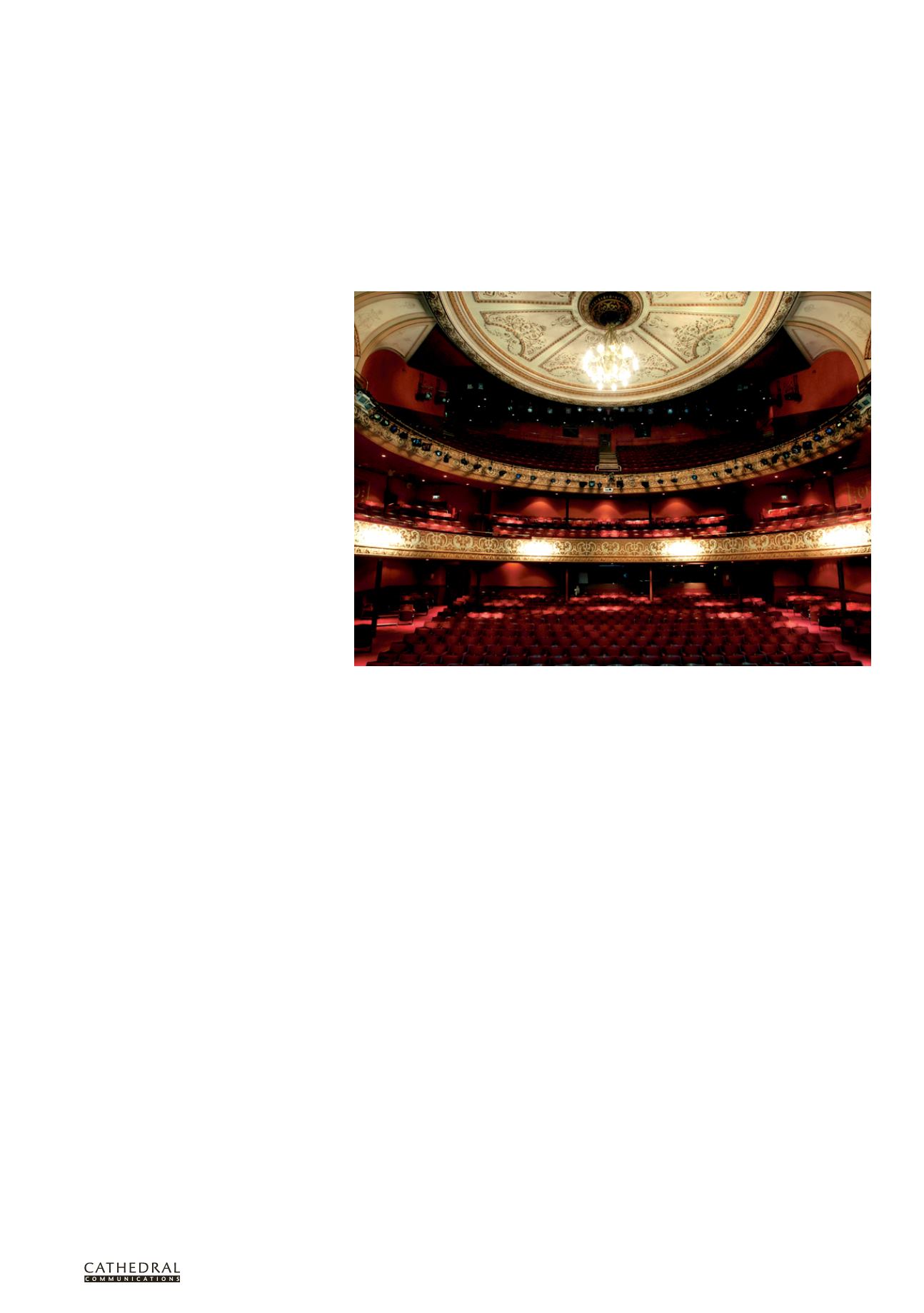

T W E N T Y T H I R D E D I T I O N
T H E B U I L D I N G C O N S E R VAT I O N D I R E C T O R Y 2 0 1 6
1 6 9
INTER IORS
5
MAINTAINING LARGE
FIBROUS PLASTER CEILINGS
RONNIE CLIFFORD
T
HE CEILING
collapse at the Apollo
Theatre in London’s West End in
December 2013 highlighted the
urgent need to effectively monitor and
maintain large suspended fibrous plaster
ceilings in hundreds of theatres and other
public buildings across the UK. Over
80 theatregoers at the Shaftesbury Avenue
venue were injured, seven seriously, when the
roof caved in during a packed performance.
The collapse could easily have resulted in
fatalities and was a wake-up call for the UK’s
theatre sector, which has been digesting the
ramifications ever since.
Initial investigations by Westminster
City Council, published in March
2014, cited weakening hessian wadding
embedded in the ceiling as the cause
of the collapse and recommended the
urgent inspection of all suspended ornate
ceilings in the city’s public buildings.
Hessian is a type of sackcloth which was
mixed into the plaster of Paris as a simple
but effective form of fibrous reinforcement,
both for the ceiling itself and for the wadding
ties which bound the ceiling to the fixings
above. It was thought that the waddings at
the Apollo had been in place since 1901 when
the Grade II listed theatre opened its doors
for the first time, and that they had become
progressively weaker.
HISTORY OF FIBROUS PLASTERWORK
While the practice of reinforcing gypsum
plaster with hessian and canvas has been
around for millennia and is thought to
predate the ancient Egyptian civilisation,
the modern approach to fibrous plasterwork
in the UK originates in the mid-1850s. In
1856 French modeller Leonard Desachy
patented a method for the production
of ‘architectural mouldings, ornaments
and other works of art formed with
surfaces of plaster’. It covered the use of
a number of materials including plaster,
glue, oil, wood, wire and woven fabric.
Desachy’s method involved the fixing
of moulded surfaces to other surfaces
using wires laid into and between two or
more layers of canvas. Flat surfaces were
strengthened with canvas, wire, hooks or
pieces of wood inserted into the plaster while
it was malleable. This approach soon became
popular across the Channel in London, where
Desachy established a manufacturing base for
fibrous plaster decorations. Architect Owen
Jones, author of
The Grammar of Ornament
(1856), became one of its first patrons. Over
the past 160 years the underlying principles
have changed little although the methods and
materials used have evolved with time.
Compared with solid plaster, fibrous
plaster offered a number of benefits. It weighs
far less and can easily be reinforced, allowing
mouldings to be prepared either on or off
site and avoiding the need to run mouldings
in situ. The use of fibrous plaster allowed for
a far more flexible approach to enrichment
that opened up possibilities for more lavish
ornamentation. As it also enabled finely
decorated plasterwork to be produced much
more cost effectively, fibrous plaster quickly
became popular with homeowners, theatre
and music hall owners, and architects,
all of whom recognised the impact of
incorporating grand plasterwork designs into
their internal architecture. Theatres across
the land were soon being transformed into
‘cathedrals of fibrous plaster architecture’
that showcased the very best craftsmanship.
You only have to look up when visiting any
of our Victorian and Edwardian theatres to
discover the power of a decorative plaster
ceiling to transform the visitor experience.
Today, venue owners or managers
are responsible for ensuring that their
plasterwork ceilings are routinely checked
by specialist contractors. If the ceiling is
deemed safe, the contractors issue a ceiling
safety certificate, which is then reviewed
by the local authority alongside the venue’s
other licence requirements.
DURABILITY
The organic materials used to reinforce
plaster are susceptible to moulds and fungi
such as dry rot. In addition, in most pre-1935
theatres the plaster was suspended from
timber struts, which offered plenty of scope
for attack by both fungal decay and insect
pests such as woodworm, often causing
irreparable damage to a building’s fabric.
However, both fungal and insect decay can
only flourish in a damp environment.
Suspended theatre ceilings built after 1935
generally adopted a different and more secure
type of attachment involving more metalwork
rather than timber and wadding made from
hessian and plaster. These ‘modern’ ceilings
are less likely to fail.
In the case of the Apollo Theatre,
moisture was not cited as a cause of the
failure of the hessian ties as the roof area
was found to be dry. However, the hessian
ties have a service life of around 80 years
so the ties at the Apollo Theatre were long
overdue for a close inspection and overhaul.
Preventive maintenance is therefore a
critical consideration when it comes to the
conservation of fibrous plasterwork.
It should also be noted that visual
inspection alone may not be enough to
identify the failure of the hessian ties.
Because the hessian is encased in plaster,
the ties may appear sound even though the
hessian inside has weakened or completely
The auditorium of the Wolverhampton GrandTheatre (Photo: Jonathan Hipkiss/Wolverhampton GrandTheatre)
















